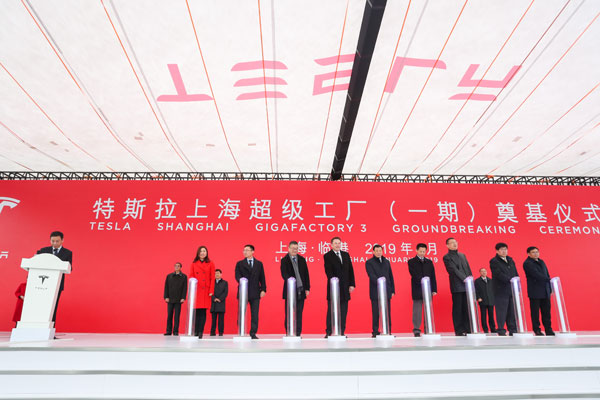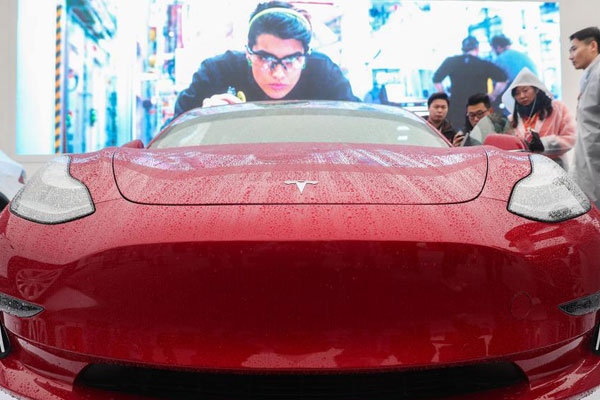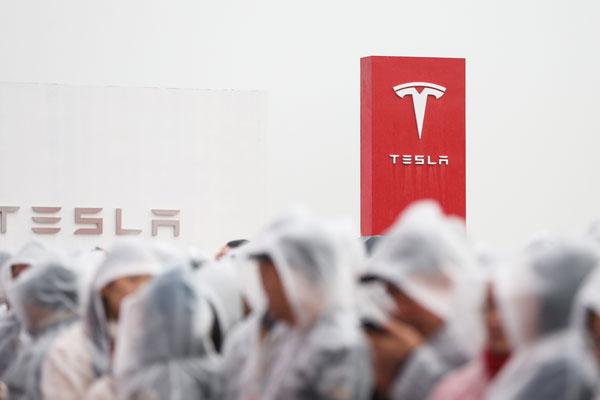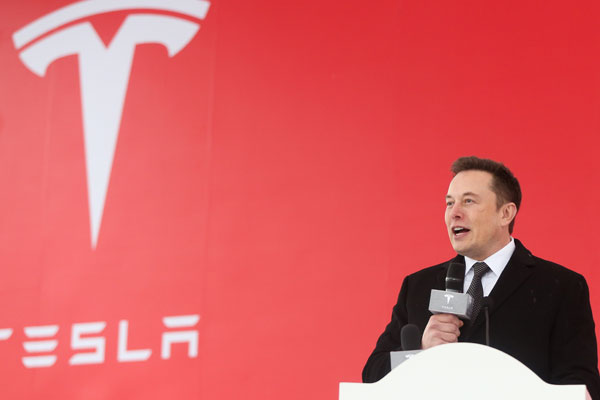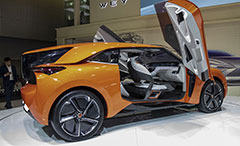Tesla breaks ground on gigafactory in Shanghai
2019-01-08
Xinhua
 US electric carmaker Tesla Inc broke ground on its Shanghai factory in Shanghai, East China, Jan 7, 2019. [Photo/Xinhua]
US electric carmaker Tesla Inc broke ground on its Shanghai factory in Shanghai, East China, Jan 7, 2019. [Photo/Xinhua]
SHANGHAI — US electric carmaker Tesla Inc on Jan 7 broke ground on its Shanghai factory, becoming the first to benefit from a new policy allowing foreign carmakers to set up wholly-owned subsidiaries in China.
The new plant, Tesla’s first outside the United States, is located in Lingang Area, a high-end manufacturing park in the southeast harbor of Shanghai. It is designed with an annual capacity of 500,000 electric cars.
Tesla signed the agreement with the Shanghai municipal government in July 2018 to build the factory. In October, the company was approved to use an 864,885-square-meter tract of land in Lingang for its Shanghai plant.
COMPETITIVE EDGE
Tesla CEO Elon Musk and Shanghai government officials attended the groundbreaking ceremony on Jan 7.
“This will be the most advanced Tesla gigafactory,” Musk said. “With resources here, we are able to build this factory in record time, and we are hoping to have initial production of Tesla Model 3 toward the end of the year and volume production next year.”
The Tesla factory, with an investment of over 50 billion yuan ($7 billion), is the largest foreign-invested manufacturing project in Shanghai’s history.
Tesla brought its Model S, Model X and Model 3 to the China International Import Expo held in November 2018 in Shanghai, aiming to reinforce its presence in the world’s largest market for electric cars.
Tesla delivered 245,240 cars in 2018 worldwide, including 145,846 Model 3.
China set a milestone record of selling 1 million new energy vehicles (NEVs) in 2018. The country aims to double the sales to 2 million in 2020.
The production at the Shanghai plant will help Tesla significantly lower its cost and prices, giving it more edge in the market competition.
Model 3, for example, which starts at a price of $35,000 in the US market, is sold between 500,000 yuan and 560,000 yuan (around $72,980 and $81,738) in China. After Tesla starts production of the model in China, the price of the car is expected to start at 400,000 yuan.
Tesla has tapped into China’s growing mainstream electric car market and established its charging network covering most cities in the country’s developed regions, such as the Yangtze River Delta in East China and the Pearl River Delta in the south.
The company set up in October 2018 its first overseas R&D innovation center in Beijing, with focus on areas such as software and hardware development, localization, China and Asia-Pacific data analysis, intelligent connected vehicles and charging technology.
“In the past five years, Tesla has witnessed Chinese car consumers’ growing awareness for environmental protection,” said Robin Ren, Tesla’s vice-president of worldwide sales.
Shen Yuxiang, a Tesla user, drives the car shuttling between Shanghai and Hangzhou, capital city of neighboring Zhejiang province, every weekend. Shen said he enjoys the 200 km ride as the car has no engine noise and boasts powerful acceleration.
CATFISH EFFECT
“Tesla’s China production will have a ‘catfish effect’ in the country’s auto industry, pushing domestic carmakers to speed up their technological upgrading,” said Cui Dongshu, secretary general of the China Passenger Car Association.
When Tesla’s plant in Shanghai starts volume production in 2020, the China-made Tesla cars will play fair with Chinese automakers, as China is scheduled to eliminate various government subsidies on NEVs by that year, Cui said.
However, Chinese automakers are not afraid of being edged out by the newcomer.
Jin Guoqing, deputy director of the automotive dynamics research institute of Chang’an Automobile, said his company has accumulated years of experience in R&D and quality control. In the meantime, it has different price positioning targeting different customers from those of Tesla.
“We shall amplify our advantages to the most,” Jin said.
From tariff cuts to removing access restrictions on foreign investment in various sectors, China has sped up in opening-up.
China’s new rules regarding the procedure to approve new Sino-foreign auto joint ventures will take effect on Jan 10. The streamlined measures will further shift the longstanding practice of checking and ratifying for the administration of auto joint ventures to the management mode of filing for record or registration only.
China unveiled a shortened negative list for foreign investment, cutting the number of items down to 48 at the moment from 63 in June 2018, which has widened market access for foreign investment in primary, secondary as well as tertiary sectors.
The German carmaker BMW announced in October last year that it would increase its stake in the joint venture, BMW Brilliance Automotive, in northeastern city of Shenyang, from 50 percent to 75 percent, and extend the cooperation for another 22 years to 2040.
Mercedes-Benz Parts Manufacturing &Service Ltd inaugurated its first factory outside Europe in October 2018 in Lingang Area, the same industrial park as Tesla Shanghai factory is located.
Shanghai resident Liu Jiang recalled that he spent 200 yuan on a bicycle when he got married in 1980. Years later, he bought his first car, a Volkswagen, and then a Nissan. Now, his child wants to buy a Tesla.
 A Tesla Model 3 is displayed at the groundbreaking ceremony of Tesla Shanghai Gigafactory in Shanghai, East China, Jan 7, 2019. [Photo/Xinhua]
A Tesla Model 3 is displayed at the groundbreaking ceremony of Tesla Shanghai Gigafactory in Shanghai, East China, Jan 7, 2019. [Photo/Xinhua]
 People are waiting for the groundbreaking ceremony of Tesla Shanghai Gigafactory to begin, Jan 7, 2019. [Photo/Xinhua]
People are waiting for the groundbreaking ceremony of Tesla Shanghai Gigafactory to begin, Jan 7, 2019. [Photo/Xinhua]
 Aerial photo taken on Jan 3, 2018 shows a tract of land for Tesla Shanghai Gigafactory in Lingang Area in Shanghai, East China. [Photo/Xinhua]
Aerial photo taken on Jan 3, 2018 shows a tract of land for Tesla Shanghai Gigafactory in Lingang Area in Shanghai, East China. [Photo/Xinhua]
 Tesla CEO Elon Musk speaks at the groundbreaking ceremony of Tesla Shanghai Gigafactory in Shanghai, East China, Jan 7, 2019. [Photo/Xinhua]
Tesla CEO Elon Musk speaks at the groundbreaking ceremony of Tesla Shanghai Gigafactory in Shanghai, East China, Jan 7, 2019. [Photo/Xinhua]
